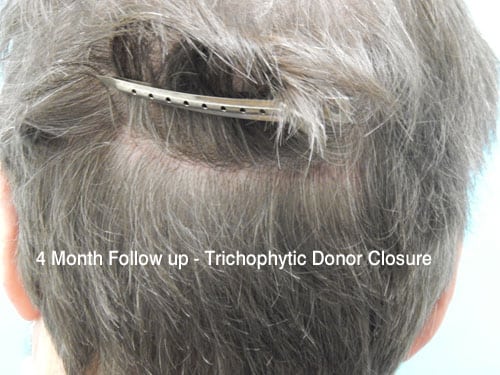Hair Transplantation
 The hairs on the sides and the back of your head are not affected by MPB. As a result a hair transplant surgeon can remove donor hair follicles from the sides and back and relocate them on the top of the scalp where hair loss has occurred and the newly transplanted hair will grow as it had from the donor region.
The hairs on the sides and the back of your head are not affected by MPB. As a result a hair transplant surgeon can remove donor hair follicles from the sides and back and relocate them on the top of the scalp where hair loss has occurred and the newly transplanted hair will grow as it had from the donor region.
Before beginning a hair transplant Dr. McGrath will review several important concerns:
- Are you in good general health?
- Do you have any bleeding or healing disorders?
- Your age and degree of hair loss.
- The quality and quantity of your donor hair.
- What is your ultimate cosmetic goal?
These are some of the most important issues in deciding whether someone is a suitable candidate for hair transplantation.
The first step in the hair transplant process is the design of the hairline. The surgeon will sketch a suggestion for placement of the hairline. You are encouraged to participate in this decision process.

Natural occurring one, two and three hair follicular units
Next, the donor area is prepared. Hair in the back is lifted and a narrow strip of hair is trimmed. The hair from above will cover the area after suturing. Both the top and the back of the scalp are then anesthetized. Patients may be given the option of a sedative while the local anesthesia is applied. This is usually the only discomfort you will feel during the procedure, and lasts only one or two minutes.
A narrow strip is removed from the donor area and the skin from above and below is brought back together with a simple running stitch. The stitches are covered by your hair and removed in about ten days, usually leaving a fine scar line that is concealed by your own hair. (It is important to note that if you shave your hair in the donor area the scar line may show.)
From the donor strip, naturally occurring Follicular Units, usually groups of 1-3 hairs, are separated under a microscope to preserve every follicle.
Dr. McGrath next creates the sites where the grafts will be placed. Tiny incisions are made at the hairline for the smallest 1 to 3 hair grafts. As the surgeon works back he will place gradually larger grafts containing Follicular Unit Groups. This allows your surgeon to accomplish more density without sacrificing naturalness. During the procedure, you will be awake and can chat with the doctor and the staff. Procedure time is usually between 3 to 6 hours and you may eat or drink during the procedure.
Ultra Refined Follicular Unit Hair Transplantation

Hair grafts are prepared using binocular microscopes
Follicular units are distinct groupings of usually one to four terminal hairs. The follicular unit is thus a naturally occurring physiologic, as well as an anatomic entity.
Follicular unit transplantation offers the surgeon the ability to transplant the maximum amount of hair with the minimum amount of non-hair bearing skin. In this way, recipient wounds are kept small, healing is facilitated, and with proper technique, large numbers of grafts may be safely moved per session. The use of these units helps to ensure that the cosmetic result of the transplant will appear completely natural.*
In contrast to follicular units, micrografts (1-2 hairs), and mini-grafts (3-6 hairs), are small grafts cut randomly from donor hair, not specifically as individual intact follicular units. These multiple units will contain extra skin that will demand larger recipient sites, which, in turn, causes more wounding to the recipient bed and may limit the number of grafts that can safely be transplanted in a session.
The evolution of microscopic dissection and follicular unit transplantation has been that this procedure can be practical for other parts of the body including eyebrows. It has also become much more viable as an alternative for female pattern hair loss which is usually more diffuse.
What Is Trichophytic Donor Closure?
The trichophytic donor closure technique is an advanced surgical technique that allows people to have a nearly undetectable linear donor scar after strip excision FUT hair transplant. Before trichophytic donor closures, or tricho closures, existed, patients were expected to have a donor scar that would range anywhere from zero to two millimeters in width. While this may not have been a problem for patients who had longer hair that could be utilized to cover the scar, the donor scar would be visible for those who had short hair. The trichophytic donor closure is an overlapping technique that allows hair to grow directly through the donor scar, resulting in the donor scar being nearly invisible.
Why Dr. McGrath Uses the Trichophytic Donor Closure Technique.
While less experienced and trained hair transplant surgeons rarely use the trichophytic donor closure technique, Dr. McGrath performs only tricophytic closure after every linear donor harvest. We understand that patients do not want a visible hair transplant scar, especially if their hair is short. The trichophytic donor closure technique is a great alternative to FUE, or follicular unit extraction, for clients who have short hair and wish to receive more hair during a single hair transplant session and at a more affordable cost.
Can Trichophytic Donor Closure Reduce Previous Hair Transplant Donor Scars?*
Patients who have also undergone previous hair restoration procedures and wish to camouflage their donor scar greatly benefit from the trichophytic donor closure technique, as well as those who are undergoing hair transplantation for the first time.



*Individual results may vary
